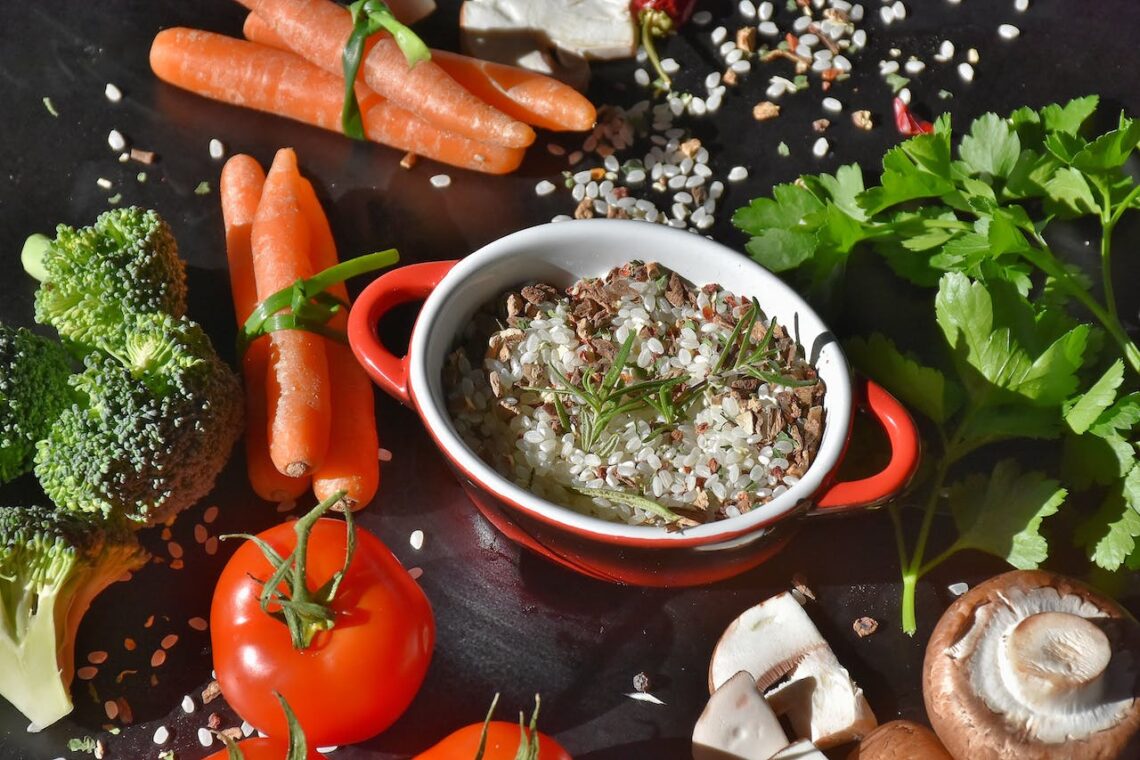
Ayurvedic Dietary Principles: Eating Right for Your Dosha
Ayurveda, the ancient system of holistic healing that originated in India, places a strong emphasis on the balance of mind, body, and spirit. Central to this philosophy are the doshas—Vata, Pitta, and Kapha—which represent the three primary energies governing our physiology.
Understanding your dominant dosha can guide you in making dietary choices that align with your unique constitution, promoting overall well-being. Let’s explore the Ayurvedic dietary principles and how you can eat right for your dosha.
Key principles of Ayurveda
Doshas:
Ayurveda recognizes the existence of three fundamental energies or doshas – Vata, Pitta, and Kapha – that govern various physiological and psychological functions in the body. Each person has a unique combination of these doshas, known as their Prakriti, which influences their physical and mental characteristics.
Five Elements:
Ayurveda is based on the concept of five elements – space, air, fire, water, and earth. These elements combine to form the doshas, and their balance is essential for maintaining good health.
Dhatus and Malas:
Ayurveda categorizes the bodily tissues (Dhatus) and waste products (Malas). The proper functioning of these elements is crucial for overall health, and Ayurveda emphasizes maintaining their balance.
Agni (Digestive Fire):
Ayurveda places great importance on digestion and metabolism, considering it a key factor in health. Agni, or the digestive fire, is responsible for breaking down and assimilating nutrients. Imbalances in Agni can lead to various health issues.
Prakriti and Vikriti:
Prakriti refers to an individual’s inherent constitution, while Vikriti refers to the current state of imbalance or disease. Ayurveda aims to restore balance and harmony between these two states through personalized lifestyle and dietary recommendations.
Holistic Approach:
Ayurveda views health as a balance between the body, mind, and spirit. It emphasizes the interconnectedness of all aspects of life and focuses on preventing illness by maintaining harmony in these areas.
Treatment Modalities:
Ayurvedic treatments include a range of therapies, herbal remedies, dietary guidelines, yoga, meditation, and lifestyle practices. These aim to bring balance to the doshas and promote overall well-being.
Individualized Approach:
Ayurveda recognizes that each person is unique, and what works for one individual may not be suitable for another. The approach is highly individualized, with treatments tailored to a person’s specific constitution, imbalances, and lifestyle.
Understanding Doshas
In Ayurveda, the three doshas – Vata, Pitta, and Kapha – are fundamental energies that govern various physiological and psychological functions in the body. Each person has a unique combination of these doshas, known as their Constitution or Prakriti, which influences their physical, mental, and emotional characteristics.
Understanding your dominant dosha is valuable as it guides personalized lifestyle choices, dietary preferences, and self-care practices to maintain or restore balance. Here’s a simple guide to help identify your dominant dosha:
Vata Dosha:
- Elements: Space (Akasha) and Air (Vayu)
- Qualities: Light, dry, cold, rough, subtle, mobile
- Functions: Governs movement, communication, creativity, and the nervous system
- Physical Characteristics: People with a predominant Vata dosha are typically slender, with a light frame. They may have dry skin, thin hair, and cold hands and feet.
- Personality Traits: Vata-dominant individuals tend to be creative, energetic, and enthusiastic. They may also be quick to learn and grasp new concepts but can be prone to anxiety and restlessness when imbalanced.
- Imbalance Manifestations: Anxiety, insomnia, digestive issues, and joint pain are common symptoms of Vata imbalance.
Pitta Dosha:
- Elements: Fire (Agni) and Water (Jala)
- Qualities: Hot, sharp, light, oily, mobile
- Functions: Governs digestion, metabolism, and transformation in the body
- Physical Characteristics: Pitta-dominant individuals often have a moderate build, a strong metabolism, and warm skin. They may tend premature graying or balding.
- Personality Traits: Pitta types are usually intelligent, focused, and driven. They have strong leadership qualities but can also be prone to irritability and impatience when out of balance.
- Imbalance Manifestations: Digestive issues, skin inflammations, acid reflux, and anger issues may arise with Pitta imbalance.
Kapha Dosha:
- Elements: Earth (Prithvi) and Water (Jala)
- Qualities: Heavy, slow, cool, oily, stable, dense
- Functions: Governs structure, lubrication, and support in the body
- Physical Characteristics: Kapha-dominant individuals tend to have a sturdy build, with a tendency to gain weight easily. They usually have smooth and oily skin, strong hair, and well-lubricated joints.
- Personality Traits: Kapha types are often calm, patient, and compassionate. They have a stable and grounded nature but can become lethargic or possessive when imbalanced.
- Imbalance Manifestations: Weight gain, lethargy, congestion, respiratory issues, and excessive sleep are common signs of Kapha imbalance.
Identifying Your Dominant Dosha:
Physical Characteristics:
- Observe your body type, skin texture, hair, and other physical attributes.
- Vata-dominant individuals are often slender with dry skin.
- Pitta types may have a moderate build with warm skin.
- Kapha individuals usually have a sturdier build and smooth, oily skin.
Mental and Emotional Traits:
- Reflect on your typical emotional responses and mental tendencies.
- Vata individuals are creative and may experience anxiety.
- Pitta types are focused but may exhibit impatience or irritability.
- Kapha personalities are calm but can become lethargic.
Reaction to External Factors:
- Consider your reactions to changes in weather, stress, and environmental factors.
- Vata types may be sensitive to cold and dry weather.
- Pitta individuals may be affected by heat and stress.
- Kapha types might be sensitive to damp or cold conditions.
Note: Most people have a combination of all three doshas, but one or two doshas are usually more dominant. Ayurveda emphasizes maintaining the balance of these doshas to promote overall health and prevent imbalances that can lead to illness.
Identifying your unique constitution (Prakriti) and recognizing imbalances (Vikriti) through an Ayurvedic assessment can guide you in making lifestyle choices, dietary adjustments, and adopting practices that support your well-being.
Ayurvedic Dietary Principles
Ayurveda places significant emphasis on the role of food in maintaining overall health and well-being. The dietary principles in Ayurveda are tailored to an individual’s dosha constitution (Prakriti) and current imbalances (Vikriti), promoting harmony and balance within the body.
One key aspect of Ayurvedic nutrition is the inclusion of the six tastes, known as “Shad Rasas,” in each meal. The six tastes play a crucial role in influencing the doshas and maintaining balance within the body. Here’s an overview of the six tastes and their significance in Ayurveda:
The Six Tastes (Shad Rasas):
Sweet (Madhura):
- Elements: Earth and Water
- Qualities: Heavy, moist, cooling
- Significance: Provides nourishment, promotes strength, soothes the nervous system, and enhances overall satisfaction. Examples include grains, sweet fruits, dairy, and natural sugars.
Sour (Amla):
- Elements: Fire and Earth
- Qualities: Heating, light, oily
- Significance: Stimulates digestion, increases appetite, and has a cleansing effect. Examples include citrus fruits, yogurt, tomatoes, and fermented foods.
Salty (Lavana):
- Elements: Water and Fire
- Qualities: Heating, heavy, moist
- Significance: Enhances taste, stimulates digestion, and supports electrolyte balance. Examples include sea salt, seaweed, and salty foods.
Bitter (Tikta):
- Elements: Air and Ether
- Qualities: Cooling, light, dry
- Significance: Detoxifies, purifies, and supports digestion. Bitter foods can promote a sense of lightness. Examples include leafy greens, turmeric, and bitter melon.
Pungent (Katu):
- Elements: Fire and Air
- Qualities: Heating, light, dry
- Significance: Stimulates digestion, enhances circulation, and promotes metabolism. Pungent foods can create warmth and increase energy. Examples include chili peppers, garlic, and ginger.
Astringent (Kashaya):
- Elements: Air and Earth
- Qualities: Cooling, dry, light
- Significance: Provides a drying and toning effect, helps in detoxification, and supports tissues. Astringent foods can create a sense of lightness. Examples include legumes, green tea, and certain fruits like pomegranates.
Dietary Principles as per Ayurveda:
- Eating According to Dosha: Ayurveda recommends that individuals tailor their diet based on their dominant dosha to maintain balance. Vata-dominant individuals may benefit from warm, nourishing foods, while Pitta types may opt for cooling and soothing choices. Kapha individuals may benefit from light, warming foods.
- Seasonal Eating: Ayurveda suggests adjusting the diet according to the seasons to maintain balance with the changing environmental influences.For instance, during the winter, Vata-pacifying foods may be emphasized to counterbalance the cold and dry qualities of the season.
- Food Quality and Freshness: Choosing fresh, organic, and locally sourced foods is encouraged in Ayurveda. The quality of food is considered crucial for maintaining the vitality and life force (Prana) within the body.
- Digestive Fire (Agni): Ayurveda places great importance on maintaining a strong digestive fire (Agni) for proper digestion and assimilation of nutrients. This involves eating mindfully, avoiding overeating, and allowing time between meals for digestion.
- Food Combinations: Ayurveda advises on proper food combinations to support optimal digestion. For example, combining certain fruits with dairy or proteins may be discouraged, as it can hinder digestion.
- Individualized Nutrition: Ayurveda recognizes that each person has a unique constitution (Prakriti), and therefore, dietary recommendations should be personalized. By understanding one’s dosha dominance, individuals can make informed choices about food that suit their specific needs.
- Awareness of Hunger and Fullness: Mindful eating involves paying attention to physical hunger cues and recognizing when you are comfortably satisfied. Avoiding overeating helps maintain optimal digestion and prevents imbalances.
- Appreciation of Flavors and Textures: Mindful eating encourages savoring each bite, and appreciating the flavors and textures of the food. This not only enhances the dining experience but also supports proper digestion.
- Preventing Imbalances: Following an Ayurvedic diet tailored to one’s dosha helps prevent imbalances associated with overconsumption or deficiency of certain tastes. For example, a Pitta-dominant individual may benefit from avoiding excess spicy or sour foods.
Note: In Ayurveda, the way we eat is considered as important as what we eat.
Customizing Your Diet for Dosha Balance
Balancing doshas through nutrition involves choosing foods and incorporating Ayurvedic herbs and spices that help pacify or harmonize each dosha. Here are some general guidelines:
1. Vata Dosha:
Strategies:
- Warm and Nourishing Foods: Include cooked grains, root vegetables, and soups to provide warmth and grounding.
- Healthy Fats: Incorporate ghee, olive oil, and avocados for nourishment and to combat dryness.
- Sweet, Sour, and Salty Tastes: Emphasize foods with these tastes to balance Vata.
Specific Foods:
Cooked grains like rice and quinoa.
- Root vegetables such as sweet potatoes and carrots.
- Warm soups with grounding spices like ginger and cumin.
- Healthy fats like ghee and sesame oil.
- Sweet fruits like bananas and dates.
Herbs and Spices:
- Ginger for warmth and digestion.
- Cinnamon for sweetness and warmth.
- Ashwagandha for its grounding and calming properties.
2. Pitta Dosha:
Strategies:
- Cooling and Hydrating Foods: Emphasize cucumber, melons, and leafy greens to balance the heat.
- Sweet, Bitter, and Astringent Tastes: These tastes help cool and balance Pitta.
- Moderate Spice: Avoid excessive heat from spicy foods.
Specific Foods:
- Cooling fruits like watermelon and coconut.
- Leafy greens such as kale and spinach.
- Sweet and juicy fruits like mangoes and berries.
- Dairy in moderation, such as coconut or goat milk.
- Whole grains like basmati rice and barley.
Herbs and Spices:
- Mint for cooling and digestive support.
- Coriander for its cooling properties.
- Fennel for its sweet and cooling nature.
3. Kapha Dosha:
Strategies:
- Light and Stimulating Foods: Opt for light and easily digestible options.
- Pungent, Bitter, and Astringent Tastes: These tastes help counter Kapha’s heaviness.
- Warm and Spicy Foods: Enhance digestion and reduce stagnation.
Specific Foods:
- Legumes and light proteins like tofu.
- Dark leafy greens such as kale and mustard greens.
- Berries and pomegranates for their astringency.
- Light and dry grains like quinoa and millet.
- Spices like black pepper and ginger.
Herbs and Spices:
- Trikatu (a blend of black pepper, long pepper, and ginger) for digestion.
- Turmeric for its anti-inflammatory properties.
- Tulsi for its uplifting and stimulating qualities.
Incorporating Ayurvedic Herbs and Spices for Optimal Health:
Turmeric (Curcuma longa):
- Benefits: Anti-inflammatory, supports digestion.
- How to Use: Add to curries, soups, or golden milk.
Ginger (Zingiber officinale):
- Benefits: Improves digestion, and reduces nausea.
- How to Use: Fresh in teas, stir-fries, or as a spice in cooking.
Cumin (Cuminum cyminum):
- Benefits: Enhances digestion, and reduces bloating.
- How to Use: Add to soups, and stews, or sprinkle on roasted vegetables.
Coriander (Coriandrum sativum):
- Benefits: Cooling, aids digestion.
- How to Use: Use fresh leaves in salads, or ground seeds in cooking.
Fenugreek (Trigonella foenum-graecum):
- Benefits: Balances blood sugar, and and supports digestion.
- How to Use: Sprinkle seeds on dishes or use in spice blends.
Triphala:
- Benefits: Promotes digestive health, and detoxification.
- How to Use: Take as a supplement or in powdered form mixed with warm water.
Ashwagandha (Withania somnifera):
- Benefits: Adaptogenic herb, that supports stress management.
- How to Use: Often taken as a supplement or added to warm beverages.
Tulsi (Ocimum tenuiflorum):
- Benefits: Adaptogenic, immune support.
- How to Use: Enjoy as a tea or add fresh leaves to salads.
General Tips:
- Hydration: Warm water or herbal teas are often preferred over cold beverages.
- Timing: Regular meal times with a focus on lunch being the main meal.
- Mindful Eating: Eat in a calm environment, savor each bite, and avoid distractions.
Lifestyle Integration
Blending Ayurvedic Dietary Principles into Daily Life:
Morning Routine:
- Start your day with a warm glass of water to kickstart digestion and hydrate the body.
- Practice oil pulling with sesame or coconut oil to promote oral health and detoxification.
Mindful Breakfast:
- Choose a breakfast that aligns with your dosha; warm oatmeal for Vata, cooling smoothie for Pitta, or a light, stimulating breakfast for Kapha.
Midday Meal:
- Make lunch the main meal of the day when digestion is strongest.
- Include a variety of colors, tastes, and textures in your lunch to balance doshas.
Afternoon Snack:
- Opt for a light and nourishing snack, such as fruit, nuts, or herbal tea.
- Take a short break to stretch or go for a gentle walk.
Evening Routine:
- Eat a lighter dinner in the early evening to allow for better digestion before bedtime.
- Practice relaxation techniques like deep breathing or gentle yoga before sleep.
Hydration Habits:
- Sip warm water or herbal teas throughout the day.
- Customize your beverages based on your dosha; for example, ginger tea for Vata, mint tea for Pitta, and spiced chai for Kapha.
Mindful Cooking and Grocery Shopping:
- Engage in mindful cooking, expressing gratitude for the ingredients.
- Prioritize fresh, seasonal, and locally sourced produce.
Awareness of Portion Sizes:
- Be mindful of portion sizes to avoid overeating and support balanced digestion.
- Listen to your body’s hunger and fullness cues.
Mindful Eating Practices:
- Create a calm and pleasant atmosphere during meals.
- Chew your food thoroughly to aid digestion and enhance nutrient absorption.
Connection with Nature:
- Spend time outdoors, connecting with nature to promote overall well-being.
- Adjust your diet seasonally to align with the changing environment.
Simple Cooking Tips in Line with Ayurvedic Principles:
Balanced Tastes:
- Aim for a balance of all six tastes (sweet, sour, salty, bitter, pungent, astringent) in each meal.
Cooking Methods:
- Vata: Use moist cooking methods like steaming and stewing.
- Pitta: Opt for moderate cooking methods like sautéing and boiling.
- Kapha: Choose dry and light cooking methods like baking, roasting, or grilling.
Individualized Adjustments:
- Customize recipes based on your dosha; for example, add warming spices for Vata or cooling ingredients for Pitta.
Spices for Balance:
- Incorporate Ayurvedic spices like turmeric, cumin, coriander, and ginger for their health benefits and flavor.
Fresh Ingredients:
- Use fresh and seasonal ingredients to maximize flavor and nutritional value.
Mindful Preparation:
- Approach cooking with a positive and calm mindset to infuse your food with good energy.
Cooking Oils:
- Vata: Use warming oils like sesame or mustard.
- Pitta: Opt for cooling oils like coconut or ghee.
- Kapha: Choose lighter oils like mustard or safflower.
Digestive Boosters:
- Include digestive aids like fennel or cumin seeds in your cooking.
- Serve a small piece of fresh ginger with a pinch of salt before meals to stimulate digestion.
Colorful Plating:
- Create visually appealing and colorful plates by incorporating a variety of fruits and vegetables.
Meal Timing:
- Stick to regular meal times to support your body’s natural circadian rhythms.
Remember that Ayurveda is about finding balance, and these tips are general guidelines. So consult with an Ayurvedic practitioner for personalized recommendations.
Ayurveda in Modern Living
Holistic Daily Routine:
Modern living often involves hectic schedules and increased stress. Incorporating Ayurvedic principles into your daily routine can provide balance. Begin the day with a grounding morning ritual, including practices such as oil pulling and gentle exercises. Structuring your day with moments of mindfulness and relaxation can counteract the fast-paced nature of modern life.
Adapting to Seasonal Changes:
Ayurveda recognizes the impact of seasonal variations on our well-being. Adjust your diet and lifestyle habits according to the seasons, emphasizing cooling foods in the summer and warming, nourishing options in the winter. Stay connected to nature, whether through outdoor activities or by incorporating seasonal produce into your meals.
Mindful Tech Use:
The prevalence of technology in modern life can disrupt our natural rhythms. Ayurveda encourages a mindful approach to technology use, suggesting designated periods for screen time and avoiding excessive exposure, especially before bedtime. This practice supports better sleep and overall balance.
Balanced Nutrition in Fast-Paced Environments:
In the rush of contemporary life, maintaining Ayurvedic dietary habits may seem challenging. However, making conscious choices can have a significant impact. Opt for fresh, whole foods over processed options. Plan and prepare simple, nutrient-dense meals, emphasizing the inclusion of diverse tastes. If time is limited, consider batch cooking and storing meals for convenience without compromising nutritional value.
Hydration and Herbal Teas:
Ayurveda places importance on proper hydration for optimal digestion and overall health. Instead of sugary or caffeinated beverages, opt for warm water or herbal teas throughout the day. Choose teas that align with your dosha or the current season to enhance balance and well-being.
Mindful Eating Practices:
Modern eating habits often involve rushed or distracted meals. Ayurveda encourages mindful eating, emphasizing the importance of sitting down to eat in a calm environment. Chew your food thoroughly to support digestion and absorption of nutrients. Create a designated space for meals, free from distractions like smartphones or television.
Individualized Approach:
While Ayurveda provides general guidelines, it is crucial to recognize individual differences. Consider consulting with an Ayurvedic practitioner to determine your unique constitution (Prakriti) and address specific imbalances (Vikriti). Personalized recommendations can enhance the effectiveness of Ayurvedic practices in modern living.
Conclusion
Ayurvedic dietary principles offer a personalized roadmap to optimal health. By embracing these guidelines tailored to your dosha, you can cultivate balance, energy, and vitality. Let the wisdom of Ayurveda guide you on a journey towards holistic well-being through conscious and mindful eating. Nurture your mind, body, and spirit through mindful eating and conscious choices.
Your path to wellness begins with the conscious choices you make daily—let Ayurveda be your guide to a harmonious and vibrant life. Start your journey today!


You May Also Like

Exploring the Doshas: Vata in Ayurveda
15 July 2023
Ayurveda: Holistic Health Tips and Remedies
28 June 2024

